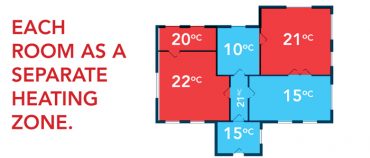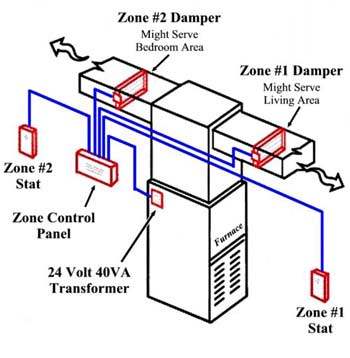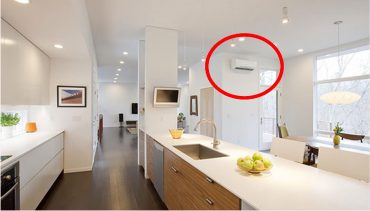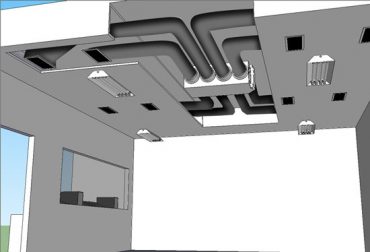
John Bleasby
Different climate control solutions have implications for contractors
Canadian ContractorSave trouble later by knowing what the mechanical system designer has specified
As homes become more energy efficient, air movement and climate control on all living space levels becomes increasingly important. There is more than one way to skin a cat, as they say, and keeping an open mind regarding solutions will mean improved energy efficiency, improved comfort and reduced risk of mold problems for your clients.

The comfort advantages of multi-zone climate control are obvious
The days of the single unit HVAC system with a central thermostat in the main hall are numbered. Homeowners no longer have to put up with eight to 10 degree temperature variations on different floors. However, as the contractor, you need to know and understand the implications of whatever HVAC choice is made either by the client or their designer. Otherwise you might run into structural problems when the time comes.
Scenario One: Single and Dual HVAC systems
A new house is an empty canvas. Designers and engineers can select a single or dual HVAC system customized to the layout and size of any house, with damper controls and multiple thermostats for specific areas.

A single source, multi-damper system means economy and maintenance simplicity
Choice One: a single system serving a dual zone environment like upstairs and downstairs
For contractors, this single heating element and/or AC coil approach means allowances for installation ducts and feeder lines more or less as usual, although there may be separate duct work for each. That could mean extra ductwork and possibly longer runs for the single heating or AC source. As a contractor and builder, you have to try to hide or disguise bulkheads as best you can. No designer or homeowner likes these visual impediments on their crisp new ceilings.
To function efficiently, the client needs to understand there is an extra cost for dual-zone temperature monitoring/control panels and the system-controlled diverter that sends the air to the side of the system that needs it (or both). However, the good news is that although the heating and AC units themselves may have to be beefed up in size, there’s less maintenance with single units than with a dual system.
Choice Two: Dual-Unit System with Separate Single-Zone HVAC units
Here is where the contractor needs to be alert. If the mechanical engineer has selected a dual system, you need to know. Typically these units are upstairs (ie. attics)-downstairs situations, so the location of each unit potentially impacts structural issues like loading on ceiling joists in the attic or rooftop, and access for installation and maintenance. On the other hand each unit can be spec’d smaller, vent runs can be shorter, and ducting reduced when the HVAC locations are strategically planned in advance.
The client will spend more money, however. Two units cost more than one, and while dual units might be helpful in the case of a unit breakdown, dual maintenance can be more expensive too. However, the dual system can potentially eliminate the need for ceiling and wall bulkheads to hide ducting. More fiddling might be required in each zone too, in order to find the right temperature balance since each unit has its own controls, even with whole-house wireless thermostat controls.
Scenario Two: The Mini-Split Solution
A great choice for renovations, multiple levels, and as a supplement to traditional heat and air conditioning sources
Mini-splits have been popular in Europe for years, says Dan Vivian, owner of VivTech Mechanical of Toronto, ON, and are quickly gaining popularity in Canada. “We see them all the time, especially in older homes where you really don’t have much room for ductwork,” says Vivian. “Over the last five years or so, it’s been huge. We install probably 50% ductless units.”

Mini-split units can be installed unobtrusively almost anywhere in the home
Mini-Splits offer flexibility in system size and area scope
The ease of installation and relatively low cost of mini-splits suit renovation situations well. Lines can run between ceiling and floors or in walls, thus reducing or eliminating the need for bulkheads. The client will also like the fact that the versatility of mini-splits allows heating or cooling in areas that are often hard to control using traditional ducted systems. “Mini splits come in different sizes,” explains Vivian. “You can either cool or heat a larger area. I’ve seen them in separate rooms like bedrooms, with ductless heads in each room. You can have one condenser with up to five or six heads off that one unit. That eliminates any ductwork. You just your line sets through to evaporate the heads, and you have cooling and heating all year round.”

Small lines for a multi-head ductless system are compact enough to run between ceiling and floor
Mini-splits run more efficiently and quietly than traditional window mount units too. And consider the air quality of older homes in particular. Air ducts must be professionally cleaned on a regular basis, and even after cleaning, dust and allergens are left behind. Ductless systems, however, offer multi-stage filtration that can drastically reduce dust, bacteria, pollen, allergens and other particulates in the air.
There are more heating and cooling choices available than just the single, dual or mini-split systems worth looking in another article. However, the main point is that there are climate control options out there, and each requires advance knowledge on the part of the contractor and builder so the correct allowances can be made physically to accommodate whatever choice is made by the client and their advisers.
Follow John on Instagram and on Twitter for notifications about his latest posts
Advertisement
Print this page


I just bought a new Sharp one with outside condenser and two inside heads. There’s no problem in AC mode, but in heating you would need two outside condensers as it’s impossible to control heat with only one condenser. I will need to spend an extra $1,000 to install another condenser… another bad experience with heat pump dealer.